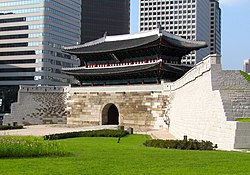37°33′36″N 126°58′31″E / 37.56000°N 126.97528°E
| Namdaemun | |
|---|---|
 Namdaemun in 2013 | |
 | |
| General information | |
| Town or city | Jung-gu, Seoul |
| Country | South Korea |
| Coordinates | 37°33′36″N 126°58′31″E / 37.56000°N 126.97528°E |
| Opened | 1398 |
| Korean name | |
| Hangul | 남대문 |
| Hanja | |
| Revised Romanization | Namdaemun |
| McCune–Reischauer | Namdaemun |
| Official name | |
| Hangul | 숭례문 |
| Hanja | |
| Revised Romanization | Sungnyemun |
| McCune–Reischauer | Sungnyemun |
Namdaemun (Korean: 남대문; lit. South Great Door), officially known as the Sungnyemun (숭례문; lit. Honoring Propriety Gate),[1] is one of the Eight Gates in the Fortress Wall of Seoul, South Korea. The gate formed the original southern boundary of the city during the Joseon period, although the city has since significantly outgrown this boundary. It is located in Jung-gu between Seoul Station and Seoul Plaza, with the historic 24-hour Namdaemun Market next to the gate.
The gate, dating back to the 14th century, is a historic pagoda-style gateway, and is designated as the first National Treasure of South Korea.[2] It was once one of the three major gateways through Seoul's city walls which had a stone circuit of 18.2 kilometres (11.3 mi) and stood up to 6.1 metres (20 ft) high. It was first built in the last year of King Taejo of Joseon's reign in 1398, and rebuilt in 1447.
In 2008, the wooden pagoda atop the gate was severely damaged by arson. Restoration work on the gateway started in February 2010 and was completed on 29 April 2013. The gate was reopened on 4 May 2013.
- ^ Yoon, Hong-key (2017). P'ungsu: A Study of Geomancy in Korea. SUNY Press. p. 217. ISBN 9781438468716.
- ^ 문교부장관 (29 December 1962). "문교부고시제169호. 《문화재보호법에의한국보지정》". 관보 (in Korean). 공보부.